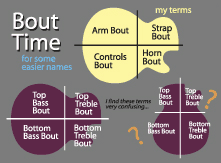Fundamentals of Electric Guitar Design, Part 2. Bout time!
In my first article I set up the very basics of electric guitar design. This time, I’ll go over some terms, and post charts of some elements I will reference later, in actual use, when I show how I tried to improve a few existing guitars in the marketplace. If you’ve done your homework you’ll have seen several hundred guitar models that have come down the pike in the last seventy years or so. You’ll know the essential Families of guitars, and the genres of music they generally become associated with. If not, go do that.
There’s your Jazzboxes, hollow bodied electrics with decent acoustic properties, semi-hollow Slimlines for fusion and rock’n’roll, singlecut solid bodies that started out Country but can be played just about anwhere, sleek solo-artist models, horned Rockers, pointy Metal thrashers, beefy Baritones, forward-looking ergonomics, kitschy plastic retro relics, sizzling silver resonators, lap steels, little tenors, and every other bloody thing anybody ever thought up.

So you can start anywhere, but all those types have things in common. Just to get it out of the way, check out my Bio Body Terms Chart, these are the words I personally use to describe guitars, and it’s quickly apparent that I lean to anatomical terms. That’s because I think everyone in any culture can relate to them. I did stop short of renaming the Volute (that extra added bump on the back of some necks that strengthens that joint or bend) the Neckbone. But there’s a few in there that will serve as handy monikers for some areas that really aren’t called anything in particular at this time.
And, then there are few headstock descriptors too, we shouldn’t neglect those. Virtually every guitar will have a body and a neck and a headstock , even if that means NO headstock. I’ll delve into them in another article soon.

Necks are not that troublesome, from the front anyway, they’re usually just tapering rectangles. Sure, some will have funky fanned frets, and fret markers that can compliment or distract from overall motifs, but it’s the body that defines a guitar model, so that’s where we should concentrate. Ever since builders left the teardrop form of the lute, mandolin and oud-type instruments behind in a quest for pushing more air out of a box, they discovered that adding an extra wiggle in the middle made the whole thing a lot stronger and allowed them to make the boxes lighter and more responsive. When that happened, the body was necessarily divided into four sections, called Bouts.
Now I’ve been around guitars for forty years and I can still never remember which bout is which, perhaps it’s a personal failure, but the current names just fuzz my brain out – and I think that’s because they seem to change when the guitar is in either the upright or laid-over (playing) position. (See my Burgundy examples above.) So, I thought, if nothing else, I could instigate the use of four new names that’ll clear that up once and for all.

They’re ambidextrous and seem easy to remember. In the diagram, the Yellow body shows them, named for their Function, rather than position. (Each is also thirty-three percent shorter. ) Now there will be times when designers place knobs and switches up in the Strap Bout, and I guess someone will design a model with just a top cutaway ‘horn’, but overall the vast majority of us should grasp these functional names because we’ve seen so many that fit the mold. So, they are, the Arm Bout, where your arm lays over the body, The Strap Bout, because that quarter has few other functions – The Control Bout, where the electronics and knobs generally go, and the Horn Bout, because that’s where most cutaways happen. Of course every time you use them you have to send me a quarter.
While we’re on the subject of Upright vs. Laid-over, I try to stick with describing guitars in the playing position, as it’s more important from a usefulness standpoint, to me that’s the essential way of looking at them. I saw a show once about a guitar company that always gave final consideration to a design in the upright or ‘hanging’ position, because that’s how buyers see them in stores. I believe that to be wholly wrong-headed, and almost certainly decided by the salesmen rather than the designers.
Guitars impart their characteristics to the player in some immeasurable way when they’re being played, so laid-over is how I design for. In addition to appearance, that’s how they have to work. Plus, they always look a bit funny Upright, because it emphasizes the long neck and head sticking out. Humans generally find more information in the top half of objects we see, so we tend to focus there. Cars, tables, trees, horizons, and other animals have most of their good stuff in the top. It’s something to remember.
Next time, I’ll go over other ways that we look at guitars, and how to use those to our advantage. Kerry Kruger. Why not join us on Facebook to keep track of all the upcoming news from Guitar Design Reviews?!

